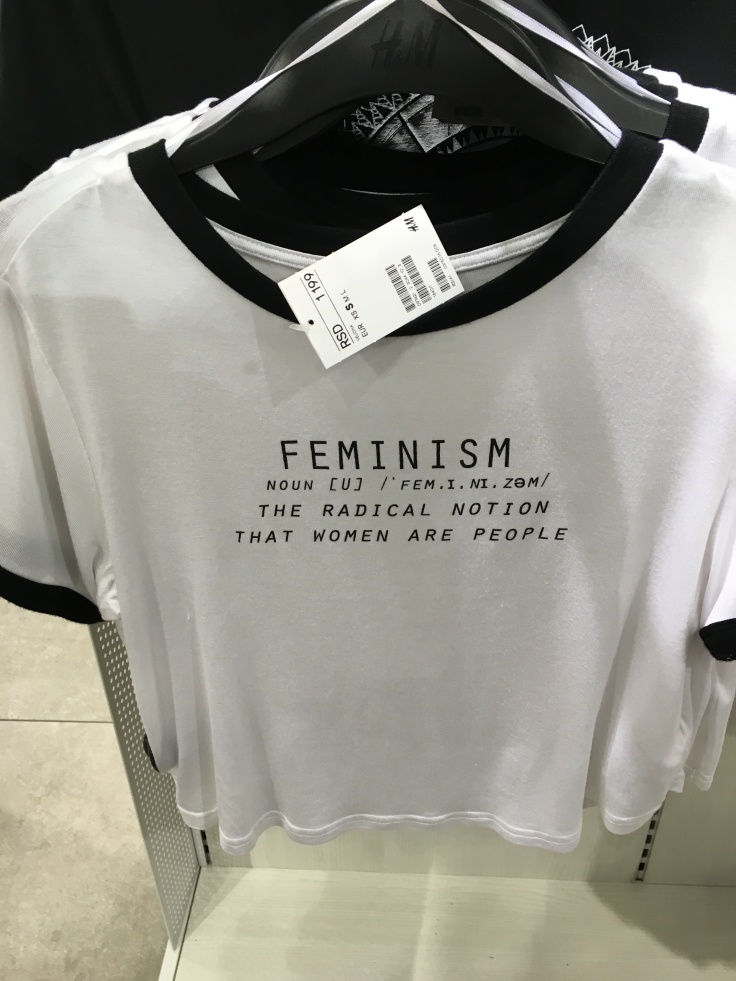
Ever since we started this fashion project, a giant elephant has been staring back at us: the unavoidable incompatibility of fashion and anti-capitalism. We consider ourselves progressive (some of us are even staunch leftists) feminists who tend to critique the matrix of domination* every chance we get. Our posts, thus far, have addressed issues surrounding race, gender performance, sexuality, age, size, orientalism, and sexism. The Textile Taxonomies page reads like a feminist studies 101 vocabulary list. But there is one glaring inconsistency that we need to address. If we are going to be a feminist scholarly blog, we need to talk about capitalism, consumerism, and the problems with fast fashion’s unjust labor policies, environmental impacts, and perpetuation of hyper consumerism.
It is no secret that we are junior scholars. Sonnet and Alex are still in graduate school finishing up their PhDs and are living off of meager TA stipends. Taneem, Cindy, and Colleen are finishing up their first years of post-defense work, which is not very lucrative (Cindy and Taneem as a post-doc fellows, and Colleen as a visiting professor). Most of the items we buy are inexpensive “fast fashion”. Fast fashion is a newish term, and it refers to the process of taking catwalk looks from a current season and rapidly mass producing and selling them at affordable prices for the masses. Think Target’s designer collabs, Uniqlo, Kohls, Topshop, Asos, H&M, Forever 21, Mango, Zara, Terranova, Stradivarius and Pull and Bear (PRIMARK ANYONE?! You should not be able to buy a sports bra for 7$ full price). Fast fashion is becoming so prevalent in U.S. consumer practices that even the mainstay “All-American” (albeit not made in the U.S.A.) brands like The Gap is considering jumping into the sea of “fast fashion.” H&M and other fast fashion brands have also (ironically) embraced Earth Day by using it to promote their brand AND come off as eco-friendly. (See H&M’s collaboration with MIA for “World Recycle Week”.)
Most of us at Sartorial Scholars regularly shop at fast fashion shops. This is in part because it is all that some of us can afford. It is also because some of us (ahem, Sonnet) enjoy wearing trendy outfits, whose staying power does not last more than a few seasons. Additionally, as young women growing up in various parts of the U.S. a major part of being socialized as girls was to learn how to be good consumers.

For Sonnet, who grew up in a middle class family in the Midwest, shopping was one of the main ways her extended family bonded:
“It might sound crass, but I have very vivid memories of bonding with my grandmother over clearance racks at the now defunct Elder-Beermans in the Cincinnati suburbs. My other grandmother pretty much only shopped at Tuesday Mornings. One of my aunts was a pro at knockoff designer handbags. You know that scene in Broad City where Ilana’s mom inspects Abbi’s purse? Yeah, that was my aunt.
I learned how to haggle and negotiate from my grandfather. That man could/can get a discount on just about anything. I also watched him go from scanning the classifieds to now perusing Craigslist. The main rule in my family has always been never buy anything at full price if you don’t have to.
So I learned about consumerism and capitalism at a very early age, and I still get a rush when I get a “great deal.” The rush fades rather quickly, though, when I think about the human cost that is associated with discounted goods in today’s globalized capitalist world.”
For Taneem, buying clothes at the mall or at “regular” stores was part of feeling like an adult:
“It’s funny how fast fashion actually marks you as a grown up. When you’re in high school, you spend time at the mall. That’s the only place to be. Though I’d have like 5$ in my purse, we’d hang out at the mall.
When I was very young, my mom sewed all of our clothes, which yes, might take the labor out of the fashion process, but the fabrics are likely produced in a fast fashion manner at any rate. But, we knew we made it when we began shopping at regular stores. When I could buy JNCO-style jeans (like the Kohl’s brand, obviously). Kohl’s was our trying to be cool in high school savior. I could buy cheap clothes, and still feel like my style was in (enough — I was never actually “in”). I know that part of my obsession with fashion now, especially fast fashion, is that when I was growing up, I didn’t have a lot of clothes. I went to an elementary and middle school that required a uniform (hand sewn by my mom), and partially because of this, in high school I had only seven shirts — one to wear a day — and maybe two pairs of pants.
In college, when I started shopping alone alone, I could buy what I wanted, so long as I had the money — and so fast fashion was a “natural” choice. I could still be on trend, but buy like a 5$ pair of jeans (like Sonnet, I grew up never buying things full price, something that I still hardly do today, and the rush of finding a great deal — it’s still very much present).”
To say that the U.S. is the land of excess and waste is probably not too much of a surprise to most people that read our blog. This is not a post about guilt associated with privilege. Rather, this is a post about being mindful as consumers, and coming to terms with the inconsistencies and sometimes incompatibilities of our politics and our desires.
Over the next few months, we will be engaging in a series of posts about mindful consumerism and fashion. We will talk about the problems associated with globalized fast fashion including detrimental environmental, social, and labor effects. We will discuss how fast fashion perpetuates a cycle of discontent that leads to further consumerism. We highlight various social and activist movements that are addressing fast fashion and hyper consumerism. We will also feature a bevy of ways to become mindful consumers, and ways we deal with consuming fast fashion while knowing it’s an incredibly problematic thing to do.
Fast fashion has become a norm of U.S. consumer habits, and we want to hear your thoughts about it too. Use the tag #SartorialScholarsFF to reach out to us on twitter, IG, or on Facebook.
*Term borrowed from Patricia Hill Collins which refers to the intersecting and overlapping systems of oppression; namely, capitalism, imperialism, sexism, homophobia, and white supremacy. We add cissexism, nationalism/ethno-centrism, and ableism to her list.



April 22, 2016 at 12:38 pm
Excited!
LikeLike
July 21, 2017 at 10:57 am
I love that I have finally discovered this blog! I was just talking about this concept exactly and I was wishing I knew of some like minded people. I can’t find the follow up posts, but I’d be excited to talk with you all at Satorial Scholars about how you envision an anti-capitalist liberating world of fashion.
LikeLike